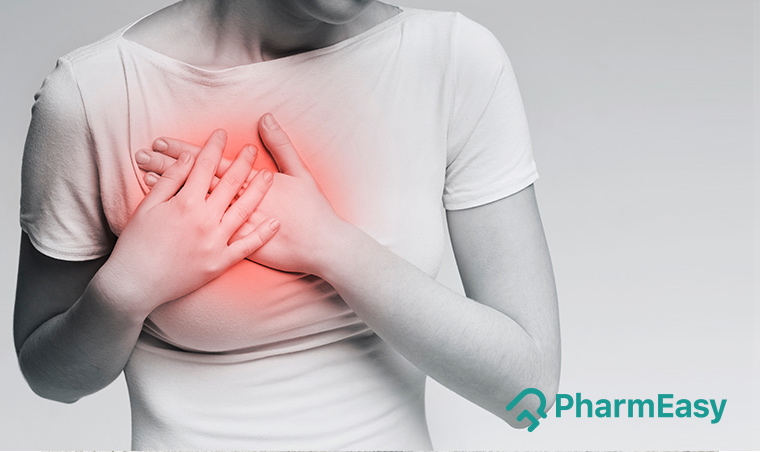What Is Mastitis? Here Are Certain Signs And Preventive Measures
By Dr. Nikita Toshi +2 more

Get,

to manage your symptom
Get your,


4 Cr+ families
benefitted

OTP sent to 9988776655



You’ve successfully subscribed to receive
doctor-approved tips on
Whatsapp

Get ready to feel your best.

Hi There,



Register to Avail the Offer
Send OTPBy continuing, you agree with our Privacy Policy and Terms and Conditions

Hi There,

Trusted by 4 crore+ families

OTP sent to 9988776655



You have unlocked 25% off on medicines




Code: NU25

By Dr. Nikita Toshi +2 more
Table of Contents
New mothers often get so busy caring for their kids that they ignore their health and well-being. With being a new mother, the body goes through a lot of changes. Lactation is one of those things. The breasts are extremely gentle and sensitive areas in the body that tend to be even more delicate during breastfeeding. Mastitis can occur to anyone but is seen more commonly in breastfeeding mothers (lactation mastitis).

Mastitis is a condition that causes inflammation of breast tissue that sometimes may involve an infection. The inflammation results in breast pain, swelling, warmth and redness. Fevers and chills are also some of the symptoms of Mastitis.
Mastitis can occur in women who aren’t breastfeeding. Even men may get Mastitis. Lactation mastitis can cause you to feel low, weary and drained, making it difficult to care for your baby. Doctors will prescribe antibiotics which have to be taken regularly. These medications will keep you going and help you get your strength as you feed your baby.
It is safe to continue breastfeeding if you have mastitis. The milk supply in the affected breast may be reduced for several weeks after mastitis but will return to normal with stimulation from the baby. Breast pain and redness often peak on the 2nd or the 3rd day and return to normal by the 5th day.
Dr. Ashish Bajaj, M.B.B.S., M.D
Signs and symptoms of Mastitis can appear suddenly. They may include:
Worldwide, lactational mastitis occurs in 2%-30% of breastfeeding women. The incidence is the highest in the first three weeks postpartum. The initial management of lactational mastitis is symptomatic treatment. Continuing to fully empty the breasts has shown to decrease the duration of symptoms in patients treated both with and without antibiotics.
Dr. M.G. Kartheeka, MBBS, MD
If you notice any symptoms of mastitis, it is best to consult with your doctor without delay and follow the full course of mastitis treatment that is prescribed to you.
The main cause of Mastitis is when milk gets trapped in the breasts. Other causes of Mastitis include:
Risk factors for mastitis include:
Also Read: Itchy Nipple: Potential Causes and Management Options
To avoid complications such as mastitis and having a healthy breastfeeding relationship with your baby, meeting with a lactation consultant at the beginning of your breastfeeding is beneficial. A lactation consultant can give you tips and provide invaluable advice when it comes to having proper breastfeeding techniques.
Some of the preventive measures that can be taken to prevent Mastitis are as follows:
Although Mastitis is a common condition that may occur in lactating women, it may be prevented by following your doctor’s advice. If conditions worsen, visit your doctor and ask for medications that will give you relief.
Also Read: Can Men Lactate? Unveiling the Surprising Biological Possibilities
Disclaimer: The information provided here is for educational/awareness purposes only and is not intended to be a substitute for medical treatment by a healthcare professional and should not be relied upon to diagnose or treat any medical condition. The reader should consult a registered medical practitioner to determine the appropriateness of the information and before consuming any medication. PharmEasy does not provide any guarantee or warranty (express or implied) regarding the accuracy, adequacy, completeness, legality, reliability or usefulness of the information; and disclaims any liability arising thereof.
Links and product recommendations in the information provided here are advertisements of third-party products available on the website. PharmEasy does not make any representation on the accuracy or suitability of such products/services. Advertisements do not influence the editorial decisions or content. The information in this blog is subject to change without notice. The authors and administrators reserve the right to modify, add, or remove content without notification. It is your responsibility to review this disclaimer regularly for any changes.

Leave your comment...
Comments